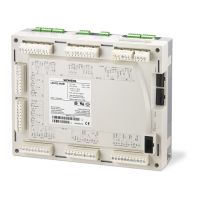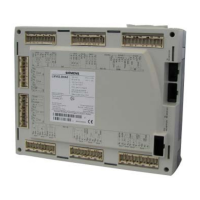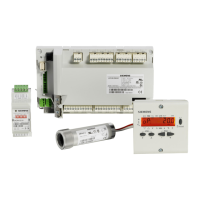Do you have a question about the Siemens LMV51.000C2 and is the answer not in the manual?
General safety warnings and precautions for LMV5 operation and installation.
Guidelines and regulations for safe and proper mounting of the LMV5 unit.
Electrical wiring, connection, and installation requirements according to national and local regulations.
Guidelines for disturbance-free signal transmission and safe electrical connection of probes.
Safety checks to be performed during commissioning and maintenance work.
Important notes regarding parameter settings, burner identification, and software usage.
Details the basic characteristics of the burner control's inputs and outputs.
Information on available connection facilities for flame detection.
Description and graphical representation of the self-test function for flame detectors.
Configuration options for separate flame supervision using multiple detectors.
Function and procedure for standardizing the flame signal display on the AZL5.
How to perform flame supervision using an external approved flame safeguard.
Supervision of combustion chamber wall temperature for high-temperature plants.
Details on the safety loop input, its function, and typical contacts.
How to manually lock the system and reset lockout or alarm states.
Using an external controller signal for heat request input.
Inputs for external controllers supporting stage/mode selection and their configuration.
Input for gas valve proving (PS-VP) or closed position indicator (CPI).
Input for gas pressure switch-min, crucial for gas shortage detection.
Input for gas start release or CPI function, detailing configurations.
Input for gas pressure switch-max to monitor gas pressure limits.
Input for oil pressure switch-min, vital for monitoring oil pressure.
Input for oil pressure switch-max to monitor oil pressure limits.
Output for connecting ignition transformers or electronic igniters for gas and oil firing.
Details on important time parameters for burner control sequences.
Lists key time parameters affecting the control sequence.
Setting reaction time for flame loss and calculating safety time.
Function and steps for gas valve proving, ensuring safety during gas firing.
Describes the lockout and safety phases, including their characteristics and transitions.
Details on prepurge time determination and skipping prepurging.
How the system handles insufficient gas pressure with selectable start attempts.
Defines addresses and parameters for actuators like air, fuel, and auxiliary actuators.
How to activate/deactivate actuators and define air influencing actuators for O2 trim.
Setting the direction of rotation (standard/reversed) for actuators.
How program phases are controlled by the burner and fuel-air ratio system.
Bringing actuators to ratio control positions after ignition for high modulation range.
Specifying actuator behavior for approaching low fire in phases 50 or 54.
Setting actuator speed for modulating operation with defined ratio control curves.
Configuring multistage operation for oil firing, defining load points.
Definition and implementation of safety time for fuel-air ratio control actuator positions.
Defining burner's working range by limiting low-fire and nominal load.
How actuators are deactivated to prevent damage from overtemperatures.
How the LMV5 can operate with internal, external, or BACS load controllers.
Using an external load controller (e.g., RWF5) with contact outputs.
Using the internal load controller of the LMV5 for standard applications.
BACS control via bus with internal load controller and external interface.
BACS control via analog input with internal load controller.
Translating analog load signal to CAN bus protocol for external control.
BACS control with digital predefined load via bus.
Defining burner operation mode as manual or automatic startup.
Load controller operation modes: modulating or multistage.
How LMV5 operates in modulating mode for gas and oil, PID algorithm use.
Manually setting PID parameters (P, I, D) or using adaption function.
How the load controller identifies the system and calculates PID parameters.
Configuring multistage operation for oil firing based on reaction thresholds.
Safety-related function to limit temperature, working like a 2-position controller.
How output steps are predefined for modulating operation.
Output steps defined by burner stages for multistage control.
Details the pin assignments for AZL5 interfaces: CAN, COM1 (PC), COM2 (BACS).
Displays for safety phase, lockout, and examples of lockout/error history messages.
Procedure for selecting main menu items and changing standard parameters.
Process for entering passwords to access parameter settings.
Procedure for addressing actuators and defining their addresses and functions.
Overview of setting fuel-air ratio control curves through selection menus.
Step-by-step guide to editing curvepoints, including adding or deleting them.
Adjusting burner curves manually with optional point storage.
Sequence steps for starting the PID parameter adaption process.
Storing burner ID for data transfer and backup/restore operations.
Performing loss-of-flame and safety limit thermostat tests, caution notes included.
Initial configuration steps including burner identification and fuel train selection.
Procedure for addressing actuators and selecting their types.
Activating/deactivating auxiliary actuators and VSD for fuel type and application.
Setting fuel-air ratio control system for gas-fired operation, including program stops.
Checking and adapting actuator positions for gas ignition.
Manually adjusting burner output and curve settings to rated capacity.
Steps to create a new curvepoint using manual operation and actuator optimization.
Checking and adapting ignition positions for oil firing.
Setting and verifying ignition positions for actuators after burner control stops in phase 36.
Changing actuator positions at ignition load or first burner stage.
Function for detecting leakage rates during valve proving.
Configuring operating modes and sensor inputs for the load controller.
Defining control parameters via standard sets, individual settings, or automatic adaption.
Acquiring system data for automatic PID parameter calculation.
Configuration of the integrated temperature limiter function.
Activation and deactivation of thermal shock protection for modulating and multistage control.
Requirements for IP40 protection, ambient temperature, unit mounting, and condensation.
Guidelines for wiring, separation of low-voltage, protection against shock, and cable types.
How the LMV5 is powered via transformer AGG5.2 and bus topology considerations.
Documenting fuel-air ratio control and O2 trim control parameters.
Importance of setting values for actuators, fuel, and air for correct operation.
Overview of LMV52's O2 trim control features and operating modes.
Technical specifications for LMV5 and AZL5, including mains voltage and safety class.
General information and function of the VSD module.
Details on VSD module inputs and outputs, including release and alarm contacts.
Configuring the VSD based on connected motor type and ramps.
Selecting and parameterizing speed sensors for motor speed acquisition.
Automatic measurement function for standardizing motor speed.
Parameterizing fuel meters for volume units and throughput.
Overview of LMV52 features including O2 trim control, actuators, VSD, and fuel throughput.
How residual O2 control reduces combustion air based on control deviation.
How precontrol calculates air rate reduction based on learned burner behavior.
Overview of operating modes for O2 trim controller and O2 alarm.
Deactivating or activating O2 trim controller/alarm via parameter settings.
Special startup modes for burners with metal mesh for O2 controller operation.
How the LMV52 initializes and releases the O2 trim controller.
Setting min/max values for O2 trim controller manipulated variable with shutdown.
Two methods to deactivate O2 trim control via mains voltage signal at input X5-03 pin 2.
Using O2 alarm with or without O2 trim control, defining minimum and maximum values.
Criteria for O2 minimum and maximum value alarms and system reactions.
Detecting aged QGO20 sensors by measuring internal resistance.
Connecting PLL52 and QGO20 for residual oxygen control on LMV52.
Configuring connected sensors via AZL5, including QGO20 and temperature sensors.
Making plant-dependent basic configurations, including actuators and VSDs.
Activating/deactivating actuators and VSDs, defining air influencing actuators for O2 trim.
Steps for commissioning the O2 trim control system.
Adjusting ratio control curves and ensuring sufficient excess O2.
Adjusting O2 alarm, initially deactivated for safety.
Setting O2 trim controller, ensuring ratio control curves and loads are correctly set.
Setting excess O2 on ratio control curve for various environmental conditions.
How FGR reduces NOx by feeding flue gas back to combustion chamber.
Defines the way auxiliary actuator 3 is driven based on FGR mode.
Setting electronic fuel-air ratio control with FGR in Time or Temperature mode.
Setting fuel-air ratio control curves without FGR influence.
Setting FGR curves with temperature compensation for LMV52.4.
General safety warnings and precautions for LMV5 operation and installation.
Guidelines and regulations for safe and proper mounting of the LMV5 unit.
Electrical wiring, connection, and installation requirements according to national and local regulations.
Guidelines for disturbance-free signal transmission and safe electrical connection of probes.
Safety checks to be performed during commissioning and maintenance work.
Important notes regarding parameter settings, burner identification, and software usage.
Details the basic characteristics of the burner control's inputs and outputs.
Information on available connection facilities for flame detection.
Description and graphical representation of the self-test function for flame detectors.
Configuration options for separate flame supervision using multiple detectors.
Function and procedure for standardizing the flame signal display on the AZL5.
How to perform flame supervision using an external approved flame safeguard.
Supervision of combustion chamber wall temperature for high-temperature plants.
Details on the safety loop input, its function, and typical contacts.
How to manually lock the system and reset lockout or alarm states.
Using an external controller signal for heat request input.
Inputs for external controllers supporting stage/mode selection and their configuration.
Input for gas valve proving (PS-VP) or closed position indicator (CPI).
Input for gas pressure switch-min, crucial for gas shortage detection.
Input for gas start release or CPI function, detailing configurations.
Input for gas pressure switch-max to monitor gas pressure limits.
Input for oil pressure switch-min, vital for monitoring oil pressure.
Input for oil pressure switch-max to monitor oil pressure limits.
Output for connecting ignition transformers or electronic igniters for gas and oil firing.
Details on important time parameters for burner control sequences.
Lists key time parameters affecting the control sequence.
Setting reaction time for flame loss and calculating safety time.
Function and steps for gas valve proving, ensuring safety during gas firing.
Describes the lockout and safety phases, including their characteristics and transitions.
Details on prepurge time determination and skipping prepurging.
How the system handles insufficient gas pressure with selectable start attempts.
Defines addresses and parameters for actuators like air, fuel, and auxiliary actuators.
How to activate/deactivate actuators and define air influencing actuators for O2 trim.
Setting the direction of rotation (standard/reversed) for actuators.
How program phases are controlled by the burner and fuel-air ratio system.
Bringing actuators to ratio control positions after ignition for high modulation range.
Specifying actuator behavior for approaching low fire in phases 50 or 54.
Setting actuator speed for modulating operation with defined ratio control curves.
Configuring multistage operation for oil firing, defining load points.
Definition and implementation of safety time for fuel-air ratio control actuator positions.
Defining burner's working range by limiting low-fire and nominal load.
How actuators are deactivated to prevent damage from overtemperatures.
How the LMV5 can operate with internal, external, or BACS load controllers.
Using an external load controller (e.g., RWF5) with contact outputs.
Using the internal load controller of the LMV5 for standard applications.
BACS control via bus with internal load controller and external interface.
BACS control via analog input with internal load controller.
Translating analog load signal to CAN bus protocol for external control.
BACS control with digital predefined load via bus.
Defining burner operation mode as manual or automatic startup.
Load controller operation modes: modulating or multistage.
How LMV5 operates in modulating mode for gas and oil, PID algorithm use.
Manually setting PID parameters (P, I, D) or using adaption function.
How the load controller identifies the system and calculates PID parameters.
Configuring multistage operation for oil firing based on reaction thresholds.
Safety-related function to limit temperature, working like a 2-position controller.
How output steps are predefined for modulating operation.
Output steps defined by burner stages for multistage control.
Details the pin assignments for AZL5 interfaces: CAN, COM1 (PC), COM2 (BACS).
Displays for safety phase, lockout, and examples of lockout/error history messages.
Procedure for selecting main menu items and changing standard parameters.
Process for entering passwords to access parameter settings.
Procedure for addressing actuators and defining their addresses and functions.
Overview of setting fuel-air ratio control curves through selection menus.
Step-by-step guide to editing curvepoints, including adding or deleting them.
Adjusting burner curves manually with optional point storage.
Sequence steps for starting the PID parameter adaption process.
Storing burner ID for data transfer and backup/restore operations.
Performing loss-of-flame and safety limit thermostat tests, caution notes included.
Initial configuration steps including burner identification and fuel train selection.
Procedure for addressing actuators and selecting their types.
Activating/deactivating auxiliary actuators and VSD for fuel type and application.
Setting fuel-air ratio control system for gas-fired operation, including program stops.
Checking and adapting actuator positions for gas ignition.
Manually adjusting burner output and curve settings to rated capacity.
Steps to create a new curvepoint using manual operation and actuator optimization.
Checking and adapting ignition positions for oil firing.
Setting and verifying ignition positions for actuators after burner control stops in phase 36.
Changing actuator positions at ignition load or first burner stage.
Function for detecting leakage rates during valve proving.
Configuring operating modes and sensor inputs for the load controller.
Defining control parameters via standard sets, individual settings, or automatic adaption.
Acquiring system data for automatic PID parameter calculation.
Configuration of the integrated temperature limiter function.
Activation and deactivation of thermal shock protection for modulating and multistage control.
Requirements for IP40 protection, ambient temperature, unit mounting, and condensation.
Guidelines for wiring, separation of low-voltage, protection against shock, and cable types.
How the LMV5 is powered via transformer AGG5.2 and bus topology considerations.
Documenting fuel-air ratio control and O2 trim control parameters.
Importance of setting values for actuators, fuel, and air for correct operation.
Overview of LMV52's O2 trim control features and operating modes.
Technical specifications for LMV5 and AZL5, including mains voltage and safety class.
General information and function of the VSD module.
Details on VSD module inputs and outputs, including release and alarm contacts.
Configuring the VSD based on connected motor type and ramps.
Selecting and parameterizing speed sensors for motor speed acquisition.
Automatic measurement function for standardizing motor speed.
Parameterizing fuel meters for volume units and throughput.
Overview of LMV52 features including O2 trim control, actuators, VSD, and fuel throughput.
How residual O2 control reduces combustion air based on control deviation.
How precontrol calculates air rate reduction based on learned burner behavior.
Overview of operating modes for O2 trim controller and O2 alarm.
Deactivating or activating O2 trim controller/alarm via parameter settings.
Special startup modes for burners with metal mesh for O2 controller operation.
How the LMV52 initializes and releases the O2 trim controller.
Setting min/max values for O2 trim controller manipulated variable with shutdown.
Two methods to deactivate O2 trim control via mains voltage signal at input X5-03 pin 2.
Using O2 alarm with or without O2 trim control, defining minimum and maximum values.
Criteria for O2 minimum and maximum value alarms and system reactions.
Detecting aged QGO20 sensors by measuring internal resistance.
Connecting PLL52 and QGO20 for residual oxygen control on LMV52.
Configuring connected sensors via AZL5, including QGO20 and temperature sensors.
Making plant-dependent basic configurations, including actuators and VSDs.
Activating/deactivating actuators and VSDs, defining air influencing actuators for O2 trim.
Steps for commissioning the O2 trim control system.
Adjusting ratio control curves and ensuring sufficient excess O2.
Adjusting O2 alarm, initially deactivated for safety.
Setting O2 trim controller, ensuring ratio control curves and loads are correctly set.
Setting excess O2 on ratio control curve for various environmental conditions.
How FGR reduces NOx by feeding flue gas back to combustion chamber.
Defines the way auxiliary actuator 3 is driven based on FGR mode.
Setting electronic fuel-air ratio control with FGR in Time or Temperature mode.
Setting fuel-air ratio control curves without FGR influence.
Setting FGR curves with temperature compensation for LMV52.4.
| Manufacturer | Siemens |
|---|---|
| Frequency | 50/60 Hz |
| Communication Protocol | Modbus RTU |
| Operating Temperature | -20 °C to +60 °C |
| Output Signal | Relay outputs |
| Ambient Temperature | -20...+60 °C |












